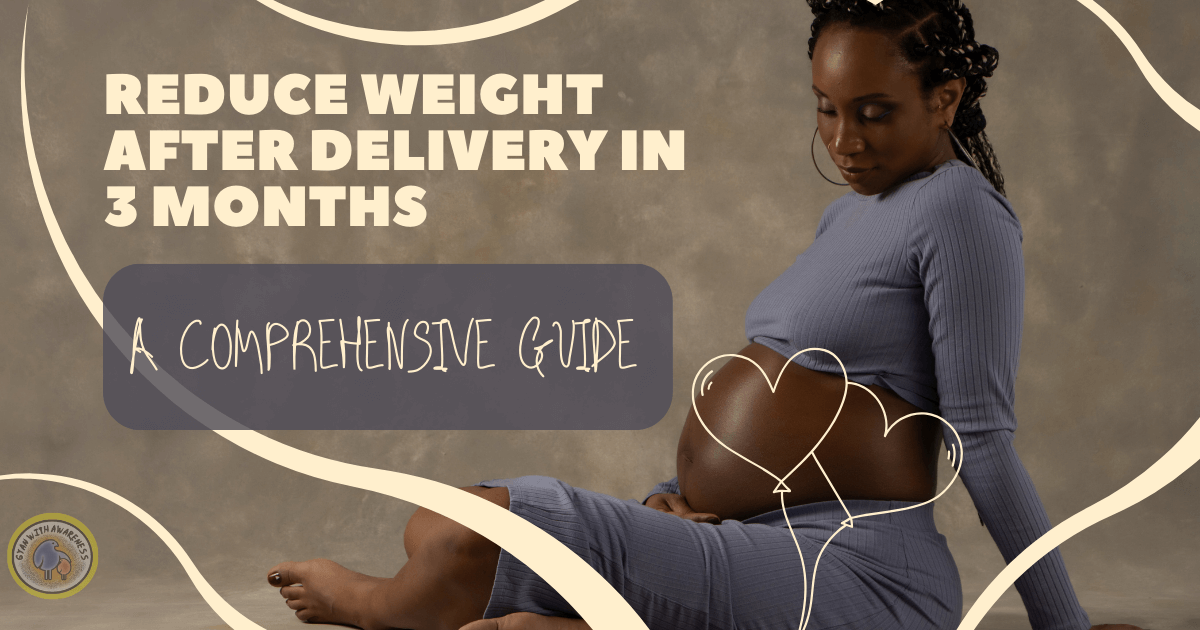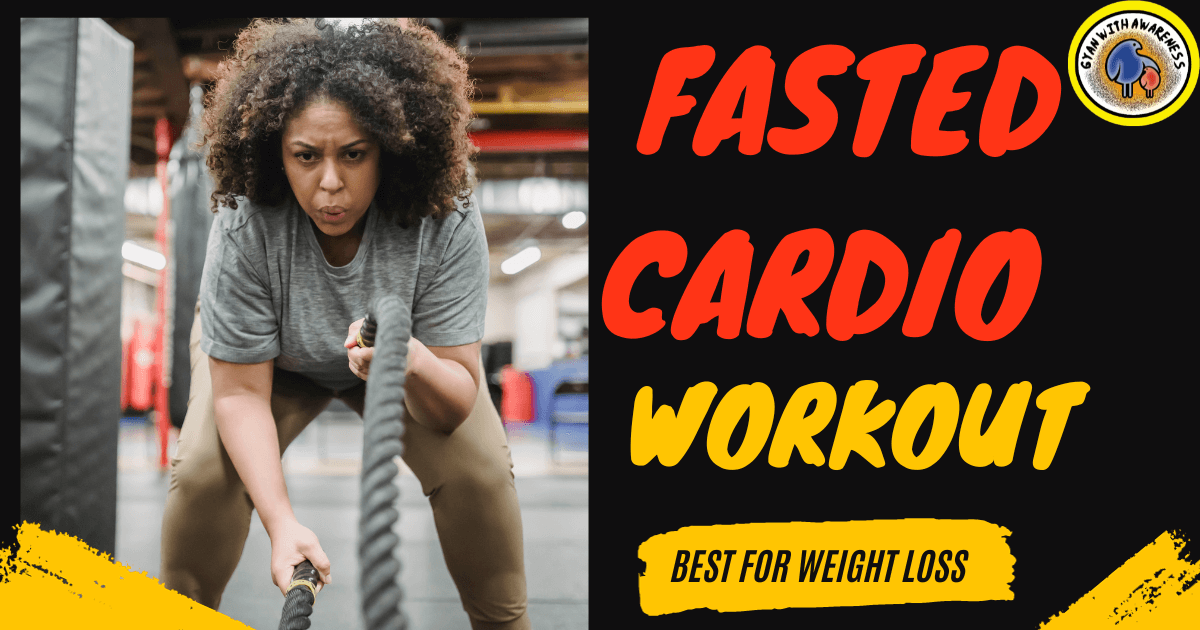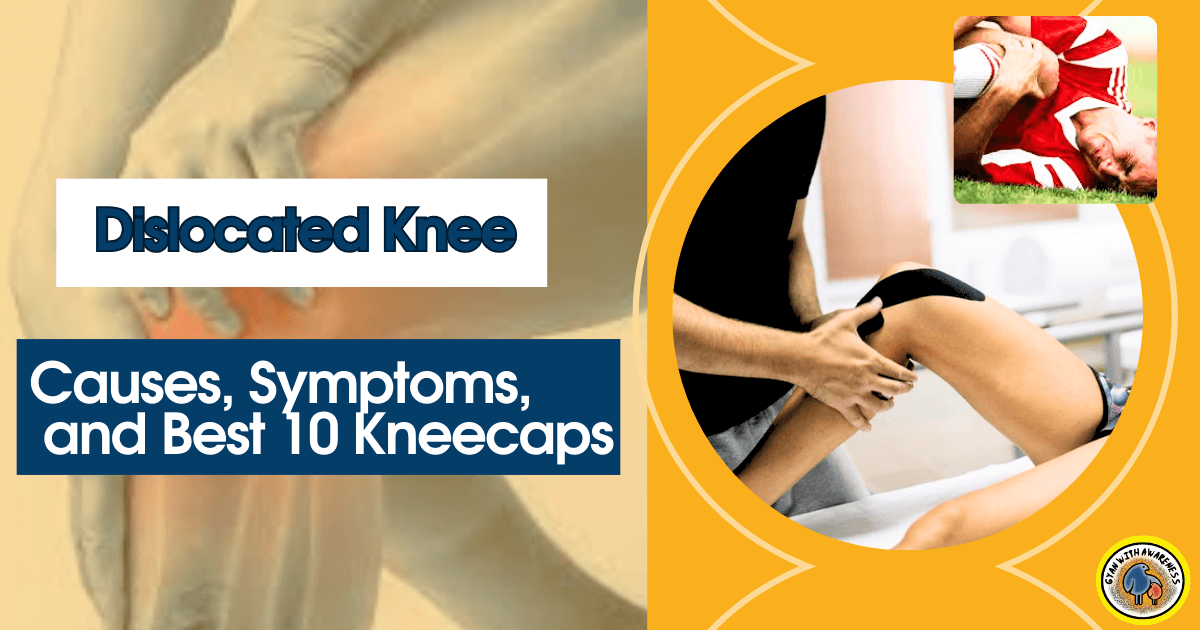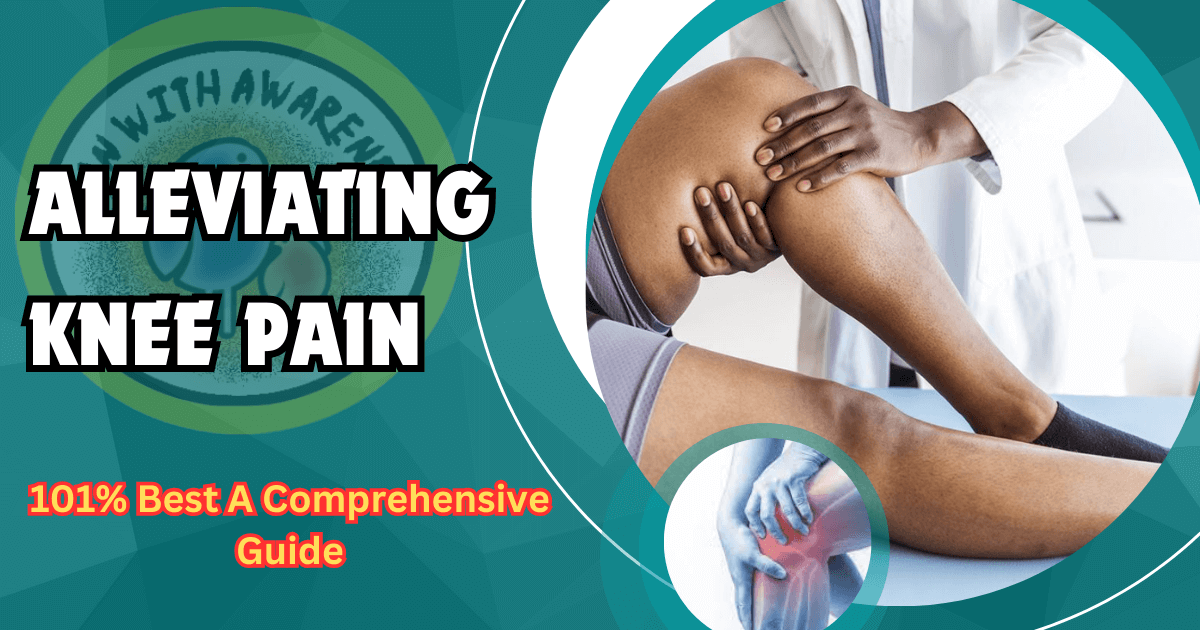Navigating Exercises After a C-Section is a roadmap through this transformation, a guide illuminating the path toward postpartum fitness for mothers who have undergone Cesarean sections. In the delicate dance of motherhood, the journey doesn’t simply end with birth—it only transforms.
In the quiet moments following the arrival of their precious newborns, these mothers find themselves at a unique intersection: balancing the demands of recovery with the desire to reclaim their strength and vitality. With each tender step forward, they navigate a landscape of physical healing and newfound responsibilities, all while yearning to reconnect with their bodies.
This narrative is not just about exercise; it’s a testament to resilience, a celebration of the human spirit’s capacity to endure and flourish. Through shared experiences and expert insights, “Beyond Birth” offers solace, encouragement, and practical wisdom, acknowledging the challenges while instilling hope. It’s a reminder that the journey of motherhood is not linear but marked by courage, grace, and the enduring pursuit of wellness.
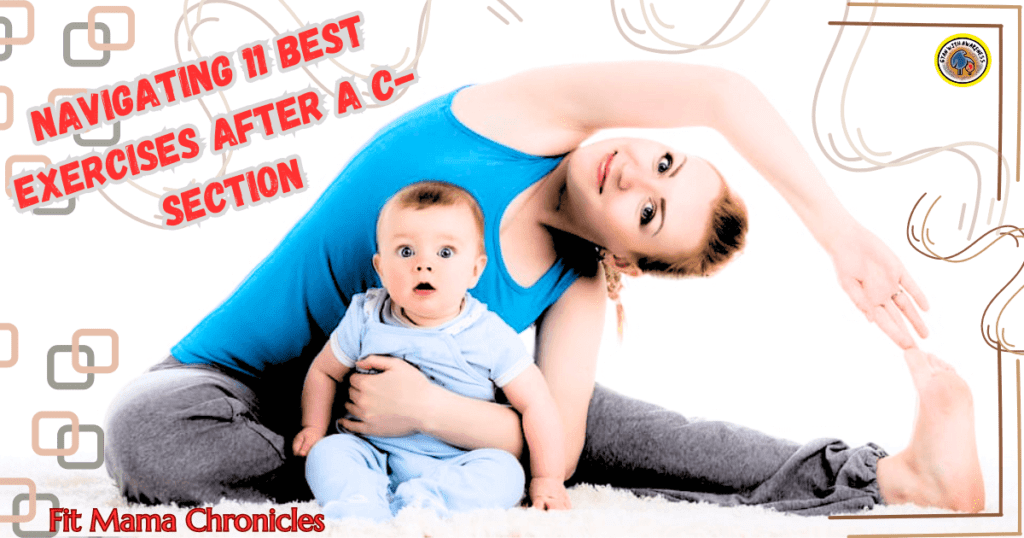
ALSO READ:
High Diastolic Blood Pressure: 100% The Silent Threat Of Health
Normal Weight Gain in Pregnancy: Best Care 21 Tips
Best 11 Foods for Pregnant Females: Nourishing Both Mom and Baby
Reduce Weight After Delivery in 3 Months: A Comprehensive Guide
51 Breakfast Ideas for High Blood Pressure
7-Days High Blood Pressure Diet Menu: Best For Heart Health
High Blood Pressure: Causes, 10 Symptoms, and Effective Treatments
Define Exercises After a C-Section:
Exercises after a C-section, or Cesarean section, are carefully curated physical activities tailored to promote safe postpartum recovery and gradual restoration of strength and mobility. These exercises prioritize gentle movements that support healing while gradually reintroducing the body to physical activity. Initially, Exercises after a C-section focus on promoting circulation, reducing swelling, and alleviating discomfort commonly associated with the surgical procedure. As recovery progresses, exercises incorporate techniques to strengthen the core muscles, particularly the abdominal muscles, which may have been affected by the surgery.
To promote the healing process and minimize tension on the incision site, emphasis is placed on appropriate breathing methods and alignment. Exercises that address pelvic floor rehabilitation post-C-section also help patients achieve maximal function and stability. They are individualized and supervised by medical personnel, taking into account the complexity of the surgery, general health, and any particular postpartum difficulties. As moms progressively restore their strength and vitality through these carefully planned activities, consistency and patience are essential.
Why Exercises After a C-Section are needed?
Exercises after a C-section is crucial for a number of reasons, the main ones being that they facilitate efficient recuperation and improve the general health of postpartum moms. Initially, they help restore muscle tone and strength, especially in the muscles of the abdomen and pelvic floor, which may have been compromised during pregnancy and further damaged by the surgery. Maintaining everyday activities and avoiding long-term consequences like back pain and pelvic floor dysfunction depend on the restoration of muscular function.
Additionally, exercises after a C-section help to improve circulation, reduce swelling, and alleviate discomfort around the incision site, facilitating faster healing. They also promote psychological well-being by providing mothers with a sense of agency and control over their bodies during the postpartum period, fostering confidence and self-esteem.
Also, following a C-section, doing the right workouts can help with long-term health advantages like better posture, more energy, and a lower chance of developing chronic illnesses linked to sedentary lifestyles. In general, post-C-section exercise is essential for easing the adjustment to motherhood and supporting the best possible physical and mental outcomes for newly moms.
Some reasons behind exercises after a C-section is needed:
Prevent Complications: Regular movement helps prevent post-surgical complications such as blood clots and respiratory issues by promoting circulation and lung function.
Alleviate Discomfort: Gentle exercises can reduce post-operative discomfort by relieving tension in the muscles surrounding the incision site and promoting better posture.
Encourage Healing: Following a C-section, physical activity increases blood flow to the surgical site, promoting quicker healing and lowering the chance of problems.
Restore Abdominal Strength: By focusing on the abdominal muscles, which may have been strained or weakened during pregnancy and surgery, these exercises help the muscles heal and strengthen the core.
Boost Energy Levels: Regular physical activity increases energy levels and combats postpartum fatigue, enhancing overall well-being.
Support Mental Health: Exercise releases endorphins, which alleviate stress, anxiety, and postpartum depression, promoting positive mental health outcomes.
Rebuild Pelvic Floor Muscles: Pelvic floor weakness following a C-section can result in problems such as incontinence. Certain workouts aid in the reconstruction of these muscles, improving bowel and urine control.
Enhance Mobility: Introducing activity gradually increases general mobility, which makes taking care of a newborn and carrying out daily tasks simpler.
Promote Weight Management: Postpartum exercise aids in shedding pregnancy weight and achieving pre-pregnancy fitness levels, boosting self-esteem and body confidence.
Facilitate Bonding: Participating in postpartum exercise classes or activities can provide social support and opportunities for bonding with other new mothers, fostering a sense of community and shared experiences.
Effects of Exercises After a C-Section:
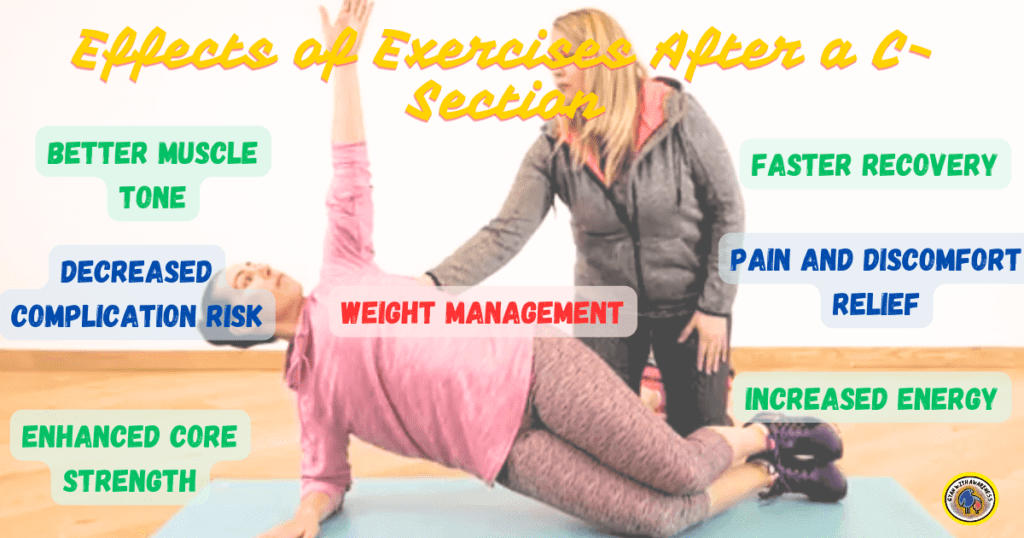
Effects of exercises after a C-section are given below:
Better Muscle Tone: Targeted workouts aid in the restoration of abdominal muscle tone, which lowers the likelihood of diastasis recti, or the separation of the abdominal muscles, and encourages a flatter stomach.
Decreased Complication Risk: By improving lung function and circulation, physical activity lowers the risk of problems following surgery, including blood clots, pneumonia, and infection.
Faster Recovery: After a C-section, regular exercise promotes tissue repair and improves blood flow to the surgical site, which expedites the healing process.
Pain and discomfort relief: By releasing tension in the surrounding muscles and encouraging improved posture, gentle movement and stretching exercises can help reduce pain and discomfort following surgery.
Enhanced Pelvic Floor Function: By strengthening and toning the pelvic floor muscles, exercises can lower the risk of pelvic organ prolapse and urine incontinence.
Enhanced Core Strength: Following a C-section, postpartum exercises concentrate on regaining core strength, which is necessary for good posture, stability, and support for the pelvis and spine.
Improved Emotional Well-Being: Engaging in regular physical activity generates endorphins, which have the potential to reduce stress, anxiety, and postpartum depression symptoms while also improving emotional well-being in general.
Increased Energy: Exercise increases vitality, fights postpartum weariness, and improves circulation and oxygen supply to tissues, all of which contribute to an increase in energy levels.
Weight Management: Engaging in postpartum exercises aids in shedding excess pregnancy weight and maintaining healthy body composition, boosting self-esteem and confidence.
Enhanced Bonding with Baby: Participating in postpartum exercise classes or activities can provide opportunities for bonding with the baby, fostering a sense of closeness and connection while promoting maternal well-being.
11 Best Exercises After a C-Section:
11 best exercises After a C-Section are given below:
1st exercises After a C-Section:
Pelvic Tilts
Follow Steps:
Rest on your back with your feet flat and knees bent.
Make use of your abdominal muscles.
Lower back onto the floor with gentle pressure.
Take a deep breath in.
Flatten your lower back and lift your pelvis upward as you exhale.
Hold on for a brief while.
Take a breath and come back to the beginning.
Ten to fifteen times, repeat.
Sync your breathing with your movements.
Pay attention to fluid, controlled motions.
Benefits: Helps strengthen the abdominal muscles without straining the incision site. Improves pelvic alignment and stability.
2nd exercises After a C-Section:
Kegel Exercises
Follow Steps:
Lie down or find a comfortable sitting position.
Your buttocks, thighs, and abdomen should all be relaxed.
Try to visualize stopping the flow of pee or stopping the passage of gas to help you identify your pelvic floor muscles.
Squeeze these muscles upward and inward to contract them.
For as long as it feels comfortable, hold the contraction for five seconds.
For the same amount of time, completely release and relax the muscles.
Ten to fifteen times in a row, repeat the contraction-relaxation cycle.
Aim for three Kegel exercises each day.
Throughout the workout, try not to tense other muscles or hold your breath.
With each gain in pelvic floor strength, gradually increase the contraction’s duration and intensity.
Benefits: Strengthens the pelvic floor muscles, reducing the risk of urinary incontinence and promoting bladder control.
3rd exercises After a C-Section:
Easy Strolling
Follow Steps:
Assume a tall stance, keeping your shoulders loose and your arms by your sides.
With your right foot, stride forward and roll it through from heel to toe.
Keeping your stride length natural, continue with your left foot after that.
For balance, gently swing your arms against your legs.
Maintain your chin horizontal to the floor and your eyes forward.
Keep a casual pace that is neither too fast nor too slow.
Breathe deeply and steadily while concentrating on your breathing.
Make use of your core muscles to provide support and stability.
Savor the sense of movement and the cadence of your steps.
Stroll for as long as it is comfortable for you; start with at least ten to fifteen minutes, and extend the time as you see fit.
Benefits: Without putting undue pressure on the body, it enhances circulation, helps avoid blood clots, and supports cardiovascular health in general.
4th exercises After a C-Section:
Leg Slides
Follow Steps:
With your knees bent and your feet flat on the floor, lie on your back on a level surface, like a yoga mat.
Keep your arms at your sides, relaxed, palms down.
To keep your lower back stable against the floor, contract your core muscles.
Keep the opposite knee bent and slowly move one leg along the floor to straighten it out.
Don’t make any jerky or abrupt movements; instead, keep your movement under control.
Return to the bent-knee posture by sliding the leg back to the beginning position.
Sliding the opposing leg out along the floor, repeat the motion.
As you slide your leg, keep your hips level, and don’t elevate or tilt them.
Avoid overstretching and aim for a light stretch at the rear of the straightened leg.
As you get more accustomed to the exercise, progressively increase the amount of repetitions you do on each leg to ten or fifteen.
Benefits: Enhances hip and lower back mobility and helps to gently engage the abdominal muscles.
5th exercises After a C-Section:
Rows of Seating with Resistance Bands
Follow Steps:
Sit on a chair or bench with your feet flat on the ground and your back straight.
Securing the other end of a resistance band under your feet, hold the other end with both hands.
Extend your arms in front of you, starting with your palms facing each other.
As you bring the resistance band closer to your body, exhale, flex your elbows, and squeeze your shoulder blades together.
Keeping your elbows close to your body, pull the band in the direction of your lower ribs.
Inhale, and then slowly release the band to extend your arms and go back to the starting position.
Maintaining your calm during the exercise will help you use your muscles more effectively.
Do this repeatedly until the necessary amount of time has passed.
Focus on engaging your back muscles while keeping your core stable.
Adjust the resistance band tension as needed to ensure challenging but manageable resistance.
Benefits: Reduces stress from nursing and baby care by strengthening the muscles in the upper back and shoulders. It also helps to improve posture.
6th exercises After a C-Section:
Pelvic Timepieces
Follow Steps:
Lay flat on your back with your feet hip-width apart and your knees bent.
Think of your pelvis as the face of a clock, in the center.
Lean your pelvis forward and lift your lower back off the floor slightly to begin at 12 o’clock.
Once you’ve held this position for a little while, take note of any minor tightness in your lower back.
You can reach six o’clock by flattening your lower back against the floor and tilting your pelvis backward.
Hold for a little duration, using your abs to keep yourself stable.
Feel the strain on either side as you attempt the pelvic tilts again at 3 o’clock to the right and 9 o’clock to the left.
Keep your spine neutral and strive for fluid, easy motions.
As your range of motion increases, progressively increase the number of repetitions you do in each direction to ten or more.
Inhale deeply, ease into each pose, and concentrate on letting go of any tightness in your hips and lower back.
Benefits: Encourages pelvic and lower back mobility and flexibility, which helps with postural realignment and lessens discomfort.

7th exercises After a C-Section:
Constant Contractures in the Abdomen
Follow Steps:
To begin, lie down on your back and correct your posture to a comfortable position.
Breathe deeply and slowly to aid with muscle relaxation.
Make every effort to release your stomach.
Try bringing your legs up to your chest or giving your abdomen a little massage to assist relax any tightness.
To aid in the relaxing of the affected area’s muscles, provide heat or cold therapy.
Stress can make stiff muscles worse, so to reduce your stress, practice mindfulness and relaxation techniques.
Avoid postures and activities that make the pain worse.
You support overall health, make sure you consume a well-balanced diet and get enough water.
See a doctor if the discomfort continues or gets worse so they can assess and treat you further.
Your healthcare professional may prescribe exercises or instructions to address the underlying cause of your frequent contractures. Pay attention to these.
Benefits: Without requiring lying down, this exercise strengthens and stabilizes the core by focusing on the deep abdominal muscles.
8th exercises After a C-Section:
Redesigned Planks
Follow Steps:
Start in the typical plank position, with your elbows under your shoulders and your forearms on the ground.
Contract your core muscles to maintain a straight body line from your head to your heels.
Make a movement by moving your weight forward and backward on your forearms in place of maintaining this still posture.
Retain stability and control throughout the entire motion.
Squeeze your glutes and contract your abdominals as you move forward.
To keep your hips from drooping as you move backward, keep your core tight.
Maintain this vigorous motion for a predetermined amount of time or repeats.
Throughout the workout, take steady breaths, inhaling as you go forward and exhaling as you move backward.
To keep your alignment correct, keep your neck loose and look down at the ground.
Once you have completed the workout, slowly reduce the intensity of the movement and go back to the initial plank position before taking a break.
Benefits: Reduces tension on the abdominal wall while strengthening the back and abdominal muscles, which are part of the core.
9th exercises After a C-Section:
Wall Push-Ups
Follow Steps:
Assume a facing position with your feet shoulder-width apart.
Place your palms at shoulder height and little wider than shoulder-width apart, keeping them flat against the wall.
Keep your arms straight and contract your core muscles.
Move back a few feet so that you form a tiny angle with the wall.
Inhale as you draw your chest near the wall and bend your elbows.
Keep your body straight from head to heels.
Exhale as you push through your hands to straighten your arms and return to the beginning position.
During the workout, be mindful to maintain your elbows close to your torso.
Aim for 10 to 15 repetitions every set, or the appropriate amount of repetitions.
As you gain strength, gradually increase the challenge by moving away from the wall or by doing standard push-ups on the floor.
Benefits: Strengthens the chest, arms, and shoulders, promoting upper body strength without excessive pressure on the abdomen.
10th exercises After a C-Section:
Seated Leg Lifts
Follow Steps:
Place your feet flat on the floor and take a seat on a firm chair.
For support, hold on to the chair’s sides.
Maintaining a straight back, raise one leg straight out in front of you.
Leg should be lowered back down after a brief period of holding.
For a predetermined number of repetitions, switch sides and repeat with the other leg.
Benefits: Strengthens the hip flexors and quadriceps while sitting, promoting lower body strength and stability.
11th exercises After a C-Section:
Pelvic Bridges
Follow Steps:
With your feet flat on the ground and your knees bent, lie on your back.
Press your lower back into the floor by using your core muscles.
Breathe in and raise your hips so that your shoulders and knees are in a straight line.
When the exercise reaches its peak, tighten your glutes.
Release the breath and return your hips to the beginning position.
Benefits: Strengthens the glutes, hamstrings, and lower back muscles, improving pelvic stability and promoting better posture.

In conclusion, exercises after a C-section are vital for promoting a smooth and effective recovery process while enhancing overall well-being for new mothers. exercises after a C-section, tailored to accommodate the body’s post-surgical needs, offer a holistic approach to healing by addressing physical, emotional, and functional aspects of postpartum recovery. By incorporating gentle movements, targeted strengthening exercises, and cardiovascular activities, mothers can regain strength, improve mobility, and reduce discomfort associated with the surgical procedure.
Moreover, engaging in postpartum exercises or exercises after a C-section fosters a sense of empowerment, promotes mental wellness, and facilitates a deeper connection with one’s body during the transformative journey of motherhood. Consistency, patience, and personalized guidance are key as mothers embark on their post-C-section exercise journey, reclaiming their vitality and embracing the joys of motherhood with renewed vigor and resilience.
Tips for Exercises After a C-Section:
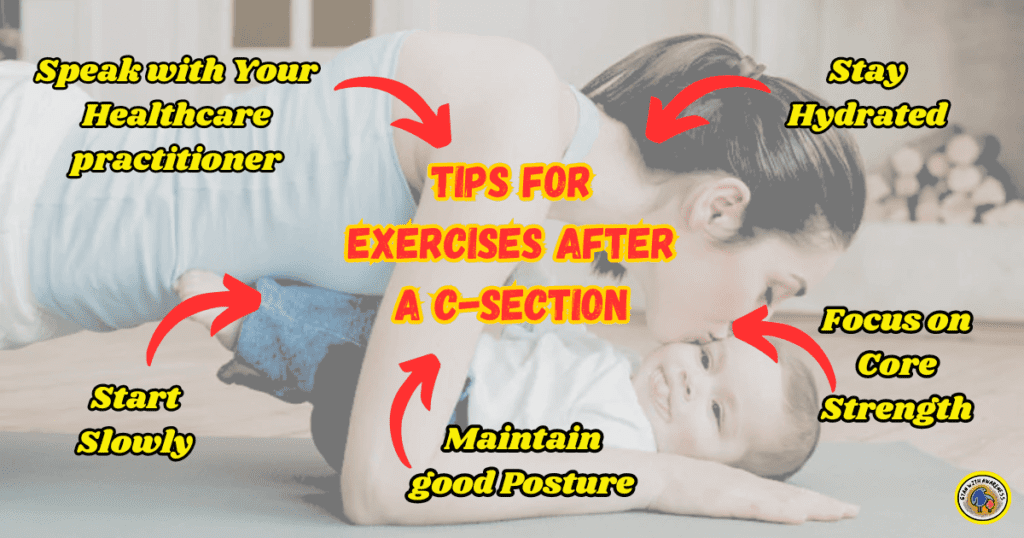
Tips for Exercises After a C-Section are following:
Tip 1 for Exercises After a C-Section
Speak with Your Healthcare practitioner: Before beginning any exercise program, make sure you have received clearance from your healthcare practitioner to engage in physical activity and to receive tailored advice based on your unique recuperation.
Tip 2 for Exercises After a C-Section
Start Slowly: As your body heals and your strength increases, start with mild workouts and progressively up the intensity. Pay attention to your body’s cues and refrain from overexerting yourself too quickly.
Tip 3 for Exercises After a C-Section
Focus on Core Strength: Incorporate core-focused exercises, such as pelvic tilts, gentle abdominal contractions, and pelvic floor exercises (Kegels), to support abdominal recovery and strengthen the core.
Tip 4 for Exercises After a C-Section
Maintain good Posture: Especially when nursing or carrying your child, pay close attention to your posture to prevent tension on your abdominal muscles and to ensure good alignment during daily tasks and exercises.
Tip 5 for Exercises After a C-Section
Stay Hydrated: If you’re nursing a baby, especially, make sure you drink lots of water before, during, and after exercise to stay hydrated. Staying well-hydrated promotes general recuperation and aids in avoiding exhaustion and cramping in the muscles
Tip 6 for Exercises After a C-Section
Pay Attention to Your Body: If you feel pain, discomfort, or strange symptoms before, during, or after an exercise session, stop right away and see your doctor. Respecting your body’s limitations and avoiding overdoing it are crucial.
Tip 7 for Exercises After a C-Section
Employ Supportive Gear: To further support the abdominal muscles and enhance comfort and stability during exercise, think about donning a supportive abdominal binder or postpartum belly wrap.
Tip 8 for Exercises After a C-Section
Incorporate Cardiovascular Exercise: Low-impact cardiovascular workouts, like walking, stationary cycling, or swimming, can improve general cardiovascular health, aid in weight loss, and boost circulation.
Tip 9 for Exercises After a C-Section
Make Rest and Recovery a Priority: Give your body enough time to rest and recuperate in between workouts. Sustaining muscle recovery and general healing requires adequate diet and quality sleep.
Tip 10 for Exercises After a C-Section
Remain Consistent: Observing progress and observing outcomes require consistency. When you progressively rebuild strength and fitness after a C-section, be patient with your body and strive for frequent, well-balanced exercise sessions that fit into your daily schedule.

FAQ
How soon after a C-section can you exercise?
It is generally advised against beginning an exercise program until after the postpartum check-up, which usually occurs 6–8 weeks after a C-section. But if it’s comfortable for the person, milder activities like walking and pelvic floor exercises can typically be started earlier. Personalized counsel from a healthcare expert is vital, as the timing may differ based on each person’s recovery. Exercises after a C-section must be done safely and effectively, which requires starting slowly and paying attention to your body’s cues.
Which exercise is best after a C-section?
Walking is one of the finest post-C-section exercises. It boosts general cardiovascular health, increases circulation, helps to prevent blood clots, and is low-impact. After surgery, walking can usually be resumed as soon as the patient feels comfortable doing so. It offers the benefits of physical activity in a mild manner for the body. Exercises that strengthen the core muscles, like pelvic tilts, mild abdominal contractions, and pelvic floor exercises (Kegels), are also highly suggested as recovery moves forward to support overall postpartum health and abdominal recovery.
How can I reduce my tummy after a C-section?
ALSO READ:
High Diastolic Blood Pressure: 100% The Silent Threat Of Health
Normal Weight Gain in Pregnancy: Best Care 21 Tips
Best 11 Foods for Pregnant Females: Nourishing Both Mom and Baby
Reduce Weight After Delivery in 3 Months: A Comprehensive Guide
51 Breakfast Ideas for High Blood Pressure
7-Days High Blood Pressure Diet Menu: Best For Heart Health
High Blood Pressure: Causes, 10 Symptoms, and Effective Treatments
